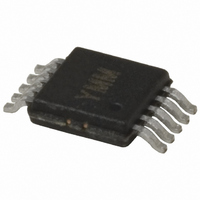MIC2169BYMM Micrel Inc, MIC2169BYMM Datasheet - Page 8

MIC2169BYMM
Manufacturer Part Number
MIC2169BYMM
Description
IC CTLR PWM BUCK SYNC 10MSOP
Manufacturer
Micrel Inc
Datasheet
1.MIC2169BYMM.pdf
(25 pages)
Specifications of MIC2169BYMM
Pwm Type
Voltage Mode
Number Of Outputs
1
Frequency - Max
550kHz
Duty Cycle
92%
Voltage - Supply
3 V ~ 14.5 V
Buck
Yes
Boost
No
Flyback
No
Inverting
No
Doubler
No
Divider
No
Cuk
No
Isolated
No
Operating Temperature
-40°C ~ 85°C
Package / Case
10-MSOP, Micro10™, 10-uMAX, 10-uSOP
Frequency-max
550kHz
Lead Free Status / RoHS Status
Lead free / RoHS Compliant
Other names
576-3641-5
MIC2169BYMM
MIC2169BYMM
Available stocks
Company
Part Number
Manufacturer
Quantity
Price
Part Number:
MIC2169BYMM
Manufacturer:
MICREL/麦瑞
Quantity:
20 000
Functional Description
The MIC2169B is a voltage-mode, synchronous step-
down switching regulator controller designed for high
power. Current limit is implemented without the use of an
external sense resistor. It includes an internal soft-start
function which reduces the power supply input surge
current at start-up by controlling the output voltage rise
time, a PWM generator, a reference voltage, two
MOSFET drivers, and short-circuit current limiting
circuitry to form a complete 500kHz switching regulator.
MIC2169B is identical to the MIC2169A except it
supports pre-bias loads and has a lower impedance
gate-drive circuit.
Theory of Operation
The MIC2169B is a voltage mode step-down regulator.
The figure above illustrates the block diagram for the
voltage control loop. The output voltage variation due to
load or line changes will be sensed by the inverting input
of the transconductance error amplifier via the feedback
resistors R3, and R2 and compared to a reference
voltage at the non-inverting input. This will cause a small
change in the DC voltage level at the output of the error
amplifier which is the input to the PWM comparator. The
other input to the comparator is a 0.95V to 1.45V
triangular waveform. The comparator generates a
rectangular waveform whose width t
time from the start of the clock cycle t
the triangle crosses the output waveform of the error
amplifier. To illustrate the control loop, let us assume the
output voltage drops due to sudden load turn-on, this
would cause the inverting input of the error amplifier,
which is divided down version of V
than the reference voltage, causing the output voltage of
the error amplifier to go high. This will cause the PWM
comparator to increase t
MOSFET, causing the output voltage to go up and
bringing V
Soft-Start
The COMP/EN pin on the MIC2169B is used for the
following three functions:
For better understanding of the soft-start feature,
assume V
power-up by un-grounding the COMP/EN pin. The
COMP pin has an internal 8.5µA current source that
charges the external compensation capacitor. As soon
as this voltage rises to 250mV (t = Cap_COMP ×
0.25V/8.5µA) and V
the MIC2169B allows the internal V
Micrel, Inc.
April 2010
1. Disables the part by grounding this pin
2. External compensation to stabilize the voltage
3. Soft-start
control loop
OUT
IN
= 12V, and the MIC2169B is allowed to
back in regulation.
IN
crosses the 2.6V UVLO threshold,
ON
time of the top side
OUT
DD
ON
, to be slightly less
linear regulator to
0
until t
is equal to the
1
, the time
8
power up, and the chip’s internal oscillator starts
switching. At this point in time, the COMP pin current
source increases to 40µA and an internal 12-bit counter
starts counting which takes approximately 2ms to
complete.
clamped at 0.65V. After this counting cycle the COMP
current source is reduced to 8.5µA and the COMP pin
voltage rises from 0.65V to 0.95V, the bottom edge of
the saw-tooth oscillator. This is the beginning of 0% duty
cycle and it increases slowly causing the output voltage
to rise slowly. The MIC2169B has one hysteretic
comparator whose output is asserted high when V
within -3% of steady state. When the output voltage
reaches 97% of programmed output voltage then the g
error amplifier is enabled along with the hysteretic
comparator output is asserted high. This point onwards,
the voltage control loop (g
control and will regulate the output voltage.
Soft-start time can be calculated approximately by
adding the following four time frames:
Current Limit
The MIC2169B uses the R
MOSFET to measure output current. Since it uses the
drain to source resistance of the power MOSFET, it is
not very accurate. This scheme is adequate to protect
the power supply and external components during a fault
condition by cutting back the time the top MOSFET is on
if the feedback voltage is greater than 0.67V. In case of
a hard short when feedback voltage is less than 0.67V,
the MIC2169B discharges the COMP capacitor to 0.65V,
resets the digital counter and automatically shuts off the
top gate drive, the g
disabled, the –3% hysteretic comparators is asserted
low, and the soft-start cycles restart from t2 to t4. This
mode of operation is called the “hiccup mode” and its
purpose is to protect the down stream load in case of a
hard short. The circuit in Figure 1 illustrates the
MIC2169B current limiting circuit.
t1 = Cap_COMP × 0.25V/8.5µA
t2 = 12 bit counter, approx 2ms
t3 = Cap_COMP × 0.3V/8.5µA
Soft-Start Time(Cap_COMP=100nF) = t1 + t2
+ t3 + t4 = 2.9ms + 2ms + 3.5ms + 1.6ms =
10ms
4 t
=
⎛
⎜ ⎜
⎝
V
During counting, the COMP voltage is
V
OUT
IN
⎞
⎟ ⎟
⎠
×
0
5 .
m
×
error amplifier is completely
Cap
m
8
error amplifier) is fully in
DS(ON)
_
5 .
COMP
µA
of the top power
M9999-041210-B
MIC2169B
OUT
is
m












